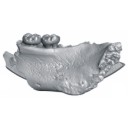
|
Enigmatic rodents from Lavergne, a late middle Eocene (MP 16) fissure-filling of the Quercy Phosphorites (Southwest France)
Keywords:
diversity; late Bartonian; Rodentia; taxonomy; Theridomyidae
doi: 10.18563/pv.47.2.e1
Cite this article:
Vianey-Liaud M., Weppe R., Marivaux L., 2024. Enigmatic rodents from Lavergne, a late middle Eocene (MP 16) fissure-filling of the Quercy Phosphorites (Southwest France)
. Palaeovertebrata 47 (2)-e1. doi: 10.18563/pv.47.2.e1
Export citation
Abstract
Two somewhat “odd” taxa of theridomyid rodents, one formerly known (Bernardia marandati Vianey-Liaud, 1991) and the other new (Idicia vidalenci gen. et sp. nov.) are discussed from a taxonomical and taphonomical perspectives. These two rodents were found at Lavergne, a late middle Eocene (MP16) “phosphatière” from the Quercy (Southwest France). The genus Bernardia, being preoccupied by a scale insect (Bernardia Ashmead, 1881), is here renamed Burgia. We benefit from this nomenclatural change to describe additional new dental specimens of this patriotheridomyine species, including a previously undescribed locus (P4). The other theridomyid from Lavergne, Idicia vidalenci gen. et sp. nov., so far documented by a mandible preserving two teeth (m2-m3) is a new taxon of peculiar occlusal morphology, and whose subfamilial affinities remain unknown. These two peculiar theridomyids recorded at Lavergne are found nowhere else, whether in coeval localities in Quercy or elsewhere in Western Europe. We discuss the possible causes of their unique presence at Lavergne.
in press
Bibliography
Ashmead, W. H., 1891. A generic synopsis of the Coccidae. Transactions of the American Entomological Society, 18, 92−102.
Crochet, J.-Y., Hartenberger, J.-L., Rage, J.-C., Remy, J.A., Sigé, B., Sudre, J., Vianey-Liaud, M., 1981. Les Nouvelles faunes de vertébrés antérieures à la “Grande Coupure” découvertes dans les phosphorites du Quercy. Bulletin du Museum national d’Histoire naturelle, Paris, 3, 245−266.
Depéret, C. Carrière, G., 1901. Sur un nouveau gisement de mammifères de l'Éocène moyen à Robiac près Saint-Mamert (Gard). Comptes Rendus de l’Académie des Sciences, 133, 616−618.
Hartenberger, J.-L., 1973a. Les rongeurs de l'Éocène d'Europe. Leur évolution dans leur cadre biogéographique. Bulletin du Museum national d’Histoire naturelle, Paris, 132, 49−70.
Hartenberger, J.-L., 1973b. Étude systématique des Theridomyoidea (Rodentia) de l'Éocène supérieur. Mémoire de la Société Géologique de France, 117, 1−76.
Hartenberger J.-L., Sigé B., Sudre J., 1974. La plus ancienne faune de mammifères du Quercy : Le Bretou. Palaeovertebrata, 6, 177−196.
Hartenberger, J.-L., Louis, P., 1976. Nouveaux rongeurs dans l’Éocène supérieur de Grisolles. Geobios, 9, 81−95. https://doi.org/10.1016/S0016-6995(76)80019-8
Hartenberger, J.-L., 1988. Le gisement du Bretou (Phosphorites du Quercy, Tarn et Garonne, France) et sa faune de Vertébrés de l’Eocène supérieur. V- Rongeurs. Palaeontographica A, 205, 103−112.
Legendre, S., Sudre, J., 1984. La communauté de mammifères de Robiac (Éocène supérieur). 10ème réunion annuelle des Sciences de la Terre, Bordeaux, 352.
Legendre, S., 1988. Le gisement du Bretou (Phosphorites du Quercy, Tarn et Garonne, France) et sa faune de vertébrés de l’Éocène supérieur. IX- Paléoécologie. Palaeontographica A, 205, 172−189.
Marivaux, L., Boivin, M., 2019. Emergence of hystricognathous rodents (Mammalia, Hystricognathi): Palaeogene fossil record, phylogeny, macroevolution and historical biogeography. Zoological Journal of Linnean Society 187, 929−964. https://doi.org/10.1093/zoolinnean/zlz048
Mourer-Chauviré, C., 1988. Le gisement du Bretou (Phosphorites du Quercy, Tarn et Garonne, France) et sa faune de Vertébrés de l’Eocène supérieur. II- Oiseaux. Palaeontographica A, 205, 29−50.
Pujol-Luz, J. R., Lamas, C. J. E., 2023a. Alone in paradise: a new genus and species of Hirmoneurini tangle-veined flies (Diptera, Nemestrinidae) in South America. Zootaxa, 5311, 123−134. https://doi.org/10.11646/zootaxa.5311.1.6
Pujol-Luz, J. R., Lamas, C. J. E., 2023b. New replacement name for Bernardia Pujol-Luz & Lamas (Diptera, Nemestrinidae, Hirmoneurini). Zootaxa, 5319, 292−292. https://doi.org/10.11646/zootaxa.5319.2.10
Remy, J. A., 2015. Les périssodactyles (Mammalia) du gisement Bartonien supérieur de Robiac (Éocène moyen du Gard, Sud de la France). Palaeovertebrata, 39, 1−98. https://doi.org/10.18563/pv.39.1.e3
Remy, J. A., Crochet, J.-Y., Sigé, B., Sudre, J., Bonis, L. de, Vianey-Liaud, M., Godinot, M., Hartenberger, J.-L., Lange-Badré, B., Comte, B., 1987. Biochronologie des phosphorites du Quercy : mise à jour des listes fauniques. Münchner Geowissenschaftliche Abh., 10, 169−188.
Schmidt-Kittler, N., Vianey-Liaud, M., Marivaux, L., 2007. The Ctenodactylidae (Rodentia, Mammalia). In: Daxner-Höck, G. (ed.), Oligocene-Miocene Vertebrates from the Valley of Lakes (Central Mongolia): Morphology, Phylogenetic and Stratigraphic Implications. Annalen des Naturhistorischen Museums in Wien, 108A, 173−215.
Sudre, J., 1969. Les gisements de Robiac (Éocène supérieur) et leurs faunes de mammifères. Palaeovertebrata, 2, 95−156. https://doi.org/10.18563/pv.2.3.95-156
Sudre, J., 1988. Le gisement du Bretou (Phosphorites du Quercy, Tarn et Garonne, France) et sa faune de Vertébrés de l'Éocène supérieur ; VII- Artiodactyles. Palaeontographica A, 205, 129−154.
Vianey-Liaud, M., 1991. Un Theridomyidae (Mammalia, Rodentia) très hypsodonte dans l'Éocène supérieur (MP16) du Quercy. Geobios, 13, 79−88. https://doi.org/10.1016/S0016-6995(66)80012-8
Vianey-Liaud, M., Schmid, B., 2009. Diversité, datation et paléoenvironnement de la faune de mammifères oligocène de Cavalé (Quercy, SO France) : contribution de l’analyse morphométrique des Theridomyinae (Mammalia, Rodentia). Geodiversitas, 31, 223−255. https://doi.org/10.5252/g2009n4a909
Vianey-Liaud, M., Ringeade, M., 1993. La radiation des Theridomyidae (Rodentia) hypsodontes à l’Eocène supérieur. Geobios, 26, 455−495. https://doi.org/10.1016/S0016-6995(06)80230-5
Vianey-Liaud, M., Marivaux, L., 2017. Autopsie d’une radiation adaptative : phylogénie des Theridomorpha, rongeurs endémiques du Paléogène d’Europe - histoire, dynamique évolutive et intérêt biochronologique. Palaeovertebrata, 40, 1−68. https://doi.org/10.18563/pv.40.3.e1
Vianey-Liaud, M., Marivaux, L., 2021. The beginning of the adaptive radiation of Theridomorpha (Rodentia) in Western Europe: morphological and phylogenetic analyses of early and middle Eocene taxa; implications for systematics. Palaeovertebrata, 44, 1−105. https://doi.org/10.18563/pv.44.2.e2
Vianey-Liaud, M., Hautier, L., 2022. Revision of the genus Protadelomys, a middle Eocene theridomyoid rodent: evolutionary and biochronological implications. Swiss Journal of Palaeontology, 141, 8 (1−98). https://doi.org/10.1186/s13358-022-00245-3
|
PDF |
|
